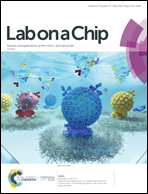Passive sweat collection and colorimetric analysis of biomarkers relevant to kidney disorders using a soft microfluidic system†
Abstract
The rich range of biomarkers in sweat and the ability to collect sweat in a non-invasive manner create interest in the use of this biofluid for assessments of health and physiological status, with potential applications that range from sports and fitness to clinical medicine. This paper introduces two important advances in recently reported classes of soft, skin-interfaced microfluidic systems for sweat capture and analysis: (1) a simple, broadly applicable means for collection of sweat that bypasses requirements for physical/mental exertion or pharmacological stimulation and (2) a set of enzymatic chemistries and colorimetric readout approaches for determining the concentrations of creatinine and urea in sweat, throughout ranges that are physiologically relevant. The results allow for routine, non-pharmacological capture of sweat for patient populations, such as infants and the elderly, that cannot be expected to sweat through exercise, and they create potential opportunities in the use of sweat for kidney disease screening/monitoring. Studies on human subjects demonstrate these essential capabilities, with quantitative comparisons to standard methods. The results expand the range of options available in microfluidic sampling and sensing of sweat for disease diagnostics and health monitoring.

- This article is part of the themed collection: Wearable and Implantable Sensors


 Please wait while we load your content...
Please wait while we load your content...
